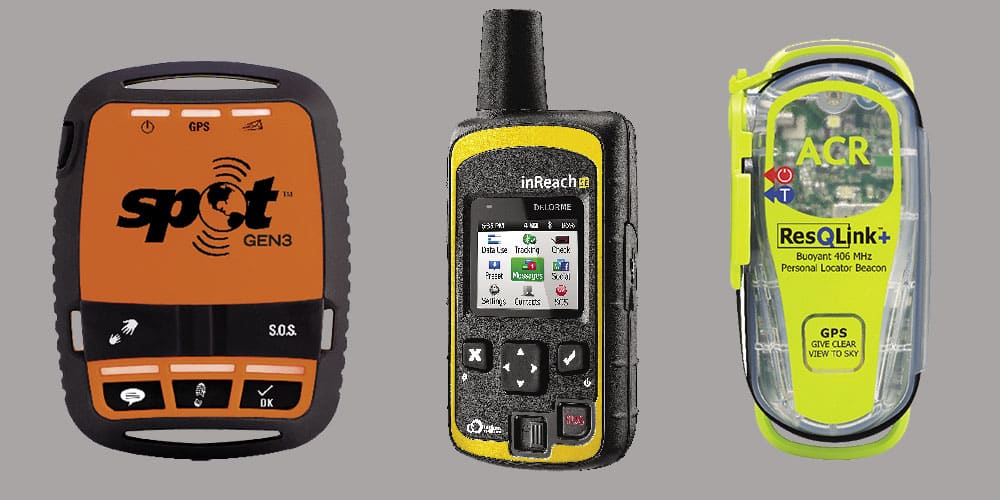
PLB lineup
Personal rescue beacons are increasingly finding their way into anglers’ tackle bags, and for many it’s not only for the ability of the devices to effect an emergency rescue, but also for their expanding role as communication devices. Because they link to satellites, they are able to function well beyond the range of cellphones and, equipped with a messaging mechanism, transmit a signal through the satellite uplink, on to a ground station and on to the Internet, where the transmission becomes a text message, an email, or GPS position or track on a map.
Spot On
One of the first of these devices to catch on with fishermen was the SPOT Satellite GPS Messenger. Along with an SOS button (which contacts the GEOS International Emergency Response Coordination Center to initiate a rescue), this robust little package features the ability to send a couple of preconfigured emails, including a nonemergency “Help” message, an “I’m OK” message, and a message of your choice, such as “I’m OK, but we are going to be later than expected” or “Fish on — fire up the grill.” Alternatively, it will post your message to Facebook or Twitter.
All messages arrive in a predetermined recipient’s email, and the current location is posted on a map located on findmespot.com, where the user, device and friends are all registered.
“Because it is a communicator, people take it along and use it, whereas with a personal locator beacon, the owner may never have to use it,” says Rich Galasso, Southeast distribution manager for SPOT. “Our customers use it all the time with Facebook and Twitter, and the SOS is just a bonus.”
SPOT’s tracking feature, which updates your location on the website map, has a lot to do with its popularity.
The newest iteration, SPOT GEN3 ($149.95), has the standard features, with the addition of adjustable tracking, which posts a new position every 60, 50, 30, 10, 5 or 2½ minutes, and a motion sensor that suspends tracking when the device senses it’s no longer moving, and restarts once you get going again.
As well, the Gen3 has a USB port for upgrades and computer linkup, and double the battery life of the previous model.
Required service plans start at $99 per year, with an upcharge for additional functions.
Enhanced communications are available with the SPOT Connect ($169.99), which links via Bluetooth to a smartphone or pad, from which you manage custom and preconfigured texts and emails. “It’s SPOT on steroids,” says Galasso. The downside is Connect requires a companion mobile device, which are often not really made for the marine environment. Complete information is on findmespot.com.
Within Reach
Moving into the realm of two-way communications is DeLorme’s inReachSE ($299), which now has a color screen, virtual keyboard, and the ability to cache and display NOAA charts downloaded from the Earthmate App for smartphones and tablets. It too has an SOS button for emergencies that initiates a full-out rescue. The interactive SOS capability automatically triggers remote tracking, and allows the user to describe and update his predicament to the rescue party.
But the interactive and social networking is just as big of a draw.
“People are seeing inReach as a communicator and lifestyle enhancer,” says Kim Stiver, vice president of marketing for DeLorme.
“We have surveyed customers, and people buy it for texting and SOS in equal numbers. It’s hard for us to distinguish a priority. People are using it for convenience and the peace of mind.”
inReachSE also has a website component, MapShare (mapshare.delorme.com), which allows others to follow a trip through the tracking feature, and even ping the location of the device.
As with the SPOT, a service plan is required. Annual plans start at basic SOS service for $9.95 a month, and top out at $65 a month for a full-service, four-month seasonal plan, with varying levels of feature activation available in between.
No Frills
While it’s a different class of device, even the venerable personal locator beacon — in particular the ResQLink+ from ACR Electronics — has taken on some aspects of a communicator, though there are notable differences in function from the DeLorme and SPOT devices.
“Ours are one-way communication devices,” says Nichole Kalil of ACR Electronics.
ResQLink does offer a function that allows you to test the 406 mHz emergency transmitter and the integral GPS, and send a position via text or email to yourself and up to five other recipients. To activate the modified test function and take advantage of its capabilities requires registration with an online service, 406Link.com. Limited to the number of tests you can do — 220 normal and 12 GPS tests over the life of the device — the ResQLink also has safeguards built in that disallow the battery level to fall below the 24-hour reserve for emergency transmitting.
The 406Link.com account monitors and records the tests, as well as battery life remaining on your PLB.
“This is an enhanced safety feature for peace of mind, not for communication,” says Gabriel Roura, ACR marketing coordinator. “It is not positioned as a communicator or a tracker.”
Standard 406Link.com service, at $39.95 a year, allows for standard self-tests (no GPS), and sends results to you and one other address. The Plus level allows for multiple recipients and GPS through-satellite tests for $59.95 a year. And with no plan at all, the ResQLink is still performs as a fully functioning emergency beacon.
“The 406Link.com is nice to have, but the ResQLink+ works fine without it,” says Kalil.









